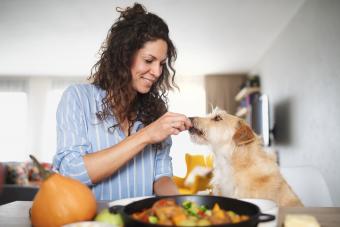
Green beans are widely recommended as a low-calorie treat option for dogs, and for good reason. If you're wondering whether dogs can eat green beans, the answer is a resounding yes. These slender legumes are a rich source of nutrients and can be prepared several ways.

Green Beans are a Healthy Treat for Dogs
Green beans are rich in essential nutrients like fiber, folic acid, iron, and vitamins D, C, A, and B6. These vitamins and minerals can help your dog by improving their immune system and fighting disease, among other health benefits. Green beans are safe for diabetic dogs and those with most other conditions.
Similar to other vegetables, green beans are very low in calories and fat. This makes them an excellent treat for dogs on a weight-loss diet. Swap traditional treats out with this healthy veggie to keep your dog's caloric intake down without depriving them of a reward.
How Many Green Beans Can a Dog Have?
Even though green beans are nutritious, they shouldn't make up too much of your dog's diet. Veterinarians recommend that treats (even healthy vegetables!) comprise no more than 10 percent of your dog's daily caloric requirements. This number depends not only on your dog's size but also their activity level, medical conditions, and unique metabolism. It's best to confirm with your vet how many calories your dog should eat each day.

Green beans weigh in at around 30 calories per cup, making them a great training treat. Thanks to their high fiber and moisture content, your dog will feel satiated after eating green beans in comparison to 30 calories of a high-density food like cheese, which is only about ½ a tablespoon.
Offer your dog green beans as a low-calorie treat, but be mindful of introducing it into their diet slowly. Too many vegetables, particularly those high in fiber and moisture, such as green beans, can cause gastrointestinal distress, vomiting, or diarrhea. Give your dog just a few pieces to start and assess how this veggie affects them.
Concerns Surrounding Legumes in Canine Diets
Significant discussion surrounds the recent reports that a grain-free diet can put dogs at risk for dilated cardiomyopathy. Many of the diets involved in this study contained potatoes, peas, and legumes as the main ingredients. Experts are investigating this relationship more closely, but some veterinarians still advise that owners avoid feeding a diet with high volumes of ingredients like legumes.
How to Prepare Green Beans for Your Dog
Preparing vegetables specifically for your dog is a little different from preparing it for a person. Flavor additives are not necessary for canines; in fact, they can be downright harmful. Keep these considerations in mind while prepping a treat or cooking a meal for your dog.
- Wash all vegetables thoroughly to remove any debris, pesticides, or bacteria from the surface.
- Cut beans into bite-sized pieces, as a long green bean is a choking hazard.
- Skip salt, spices, seasonings, and other additives.
- Avoid using butter or oil.
- When using canned green beans, rinse and drain to reduce the salt content.
Serving Ideas
This versatile veggie can be served to dogs in many different ways. Try out a few or all these ideas to determine which your dog likes best.
- Raw: Raw, cut green beans are safe for dogs. In fact, many pups actually enjoy the crunch that this raw veggie offers. However, raw legumes contain a protein called lectin, which can cause digestive issues if consumed in excess. If your dog doesn't tolerate raw beans, cook them to inactivate the lectins.
- Frozen: You can also serve frozen green beans as a cool summer treat. Grab a package of frozen cut green beans or freeze them yourself.
- Cooked: If you choose to cook them, the best methods are to steam, boil, or blanch green beans, as these eliminate the need for oils or butter.
- Pureed: Blend fresh, frozen, or cooked green beans to create a dog-friendly puree. You can put a bit in their food, smear some on a tactile feeding mat, or freeze them into pupsicles.
- Dehydrated: With the help of a dehydrator, you can make crispy, low-calorie treats for your dog. Simply dehydrate cut green beans then serve!
- Canned: In a pinch, canned green beans will do. Select only low-sodium or "no salt added" varieties.
Ingredients in Green Bean Dishes to Avoid
Whether it's a traditional casserole or another green bean dish, there's a good chance the human concoction you want to share with your dog contains ingredients that are toxic to them. Avoid feeding your pet green beans cooked with any of the following food items.

- Onion (including fried onion toppings)
- Garlic
- Chives
- Oil or butter
- Spices, herbs, and seasonings
- Added salt
Limit Sodium Intake
Salt intake can be a concern for dogs. Canned green beans and prepared dishes often contain high levels of added salt. Although dogs need sodium chloride to function, they obtain this compound from a balanced dog food; there's no need to add more. In fact, too much salt can be harmful to dogs.
High salt intake can lead to elevated blood pressure and is especially dangerous for dogs with cardiac or kidney conditions. Dogs who ingest more than 1 gram of salt for every 1 pound of body weight are at risk for salt toxicity, a life-threatening condition. Be aware of the salt content in the foods you offer our pup. Purchase low-sodium or "no salt added" green beans if you decide to go the canned route.
Can Dogs Eat Green Beans?
Green beans are a healthy and safe dog treat choice. Consider using this in place of high calorie treat options if your pet is overweight. If your dog eats a high volume of green beans, monitor them for signs of vomiting or diarrhea. However, if they consume a dish containing toxic ingredients, contact your veterinarian immediately.







